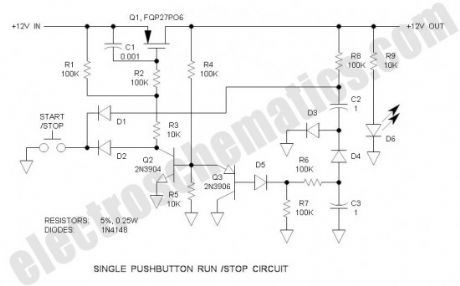Basic Circuit
Single Pushbutton Run-Stop Circuit
Published:2013/10/13 20:37:00 Author:lynne | Keyword: Single Pushbutton Run-Stop Circuit | From:SeekIC

There are solutions to this problem—mechanical (push On/push Off switch), electromagnetic (latching relay) and electronic (CMOS logic), but few (if any) good discrete electronic solutions. I have scoured the web, looking for such and have not found any decent circuits. One recent job required such and I had to resort to CMOS logic — I will be posting that one in the future.
As a result, I have been racking my brain for the last few months and have finally come up with a really neat circuit. It is a little busy, having 19 components, but they are small, inexpensive and commonly available.
What are the benefits of such a circuit?
Good question — one may wonder what use this could be. Besides being compatible with any normally open pushbutton, it is a great way to add multiple pushbuttons to a system—all normally open pushbuttons are simply wired in parallel — any can start or stop the device. Also note that push-on/push-off switches are quite special and have a limited offering in regard to size, mechanics and aesthetics—they also have an unpleasant feel, in my estimation.
Single Pushbutton Run-Stop Schematic
How it works
When the pushbutton is initially closed, it directly turns on the gate of Q1 via D2. Q1 turns on after a brief delay determined by the charge time of C1. Q1 then biases Q2 on, and Q2 seals in the pushbutton signal and C2 charges up to 12V via R8 and D2.
When the pushbutton is closed again, the top side of C2 is grounded via the pushbutton action through D1. The lower side of C2 goes negative and dumps half of its charge into C3. The negative voltage on C3 turns on Q3 that is connected in the common collector configuration (emitter follower). The emitter of Q3 shorts the bias voltage of Q2 to common thus turning off Q1 (as soon as the pushbutton is released).
Reprinted Url Of This Article:
http://www.seekic.com/circuit_diagram/Basic_Circuit/Single_Pushbutton_Run_Stop_Circuit.html
Print this Page | Comments | Reading(3)

Article Categories
power supply circuit
Amplifier Circuit
Basic Circuit
LED and Light Circuit
Sensor Circuit
Signal Processing
Electrical Equipment Circuit
Control Circuit
Remote Control Circuit
A/D-D/A Converter Circuit
Audio Circuit
Measuring and Test Circuit
Communication Circuit
Computer-Related Circuit
555 Circuit
Automotive Circuit
Repairing Circuit
Code: